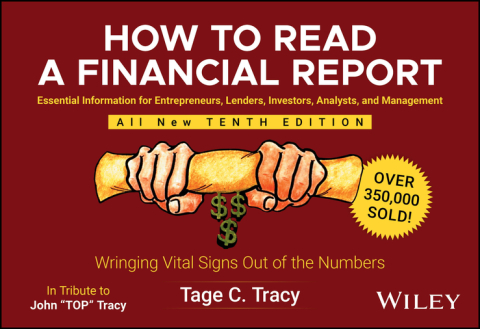Description
Efnisyfirlit
- Cover
- Table of Contents
- Title Page
- Copyright
- LIST OF EXHIBITS
- PREFACE TO THE TENTH EDITION
- Part One: FUNDAMENTALS
- 1 ARMING YOU WITH ESSENTIAL KNOWLEDGE
- What Is a Financial Report?
- Financial Information and the Big Three Financial Statements
- Let’s Speak the Proper Language
- A Final Word before You Dive into the Rest of the Book
- 2 STARTING WITH CASH FLOWS
- Summary of Cash Flows for a Business
- What Does the Cash Flows Summary Not Tell You?
- Profit Is Not Measured by Cash Flows
- Cash Flows Do Not Reveal Financial Condition
- A Few Additional Thoughts to Keep in Mind
- 3 BEDROCK FINANCIAL STATEMENT #1: THE INCOME STATEMENT
- The Income Statement: A Closer Look
- Reporting Profit Performance: The Income Statement
- 4 BEDROCK FINANCIAL STATEMENT #2: THE BALANCE SHEET
- Reporting Financial Condition: The Balance Sheet
- 5 REPORTING CASH FLOWS
- The Statement of Cash Flows
- Cash versus Accrual Accounting
- Financial Tasks of Business Managers
- Part Two: CONNECTIONS
- 6 FITTING TOGETHER FINANCIAL STATEMENTS
- One Problem in Financial Reporting
- Connecting the Dots
- 7 SALES REVENUE AND ACCOUNTS RECEIVABLE
- Exploring One Link at a Time
- How Sales Revenue Drives Accounts Receivable
- Accounting Issues
- 8 COSTS OF SALES REVENUE, INVENTORY, AND ACCOUNTS PAYABLE
- Acquiring Inventory on the Cuff
- Accounting Issues: Accounts Payable
- Holding Products in Inventory Until They Are Sold
- Inventory Control
- Accounting Issues
- 9 OPERATING EXPENSES AND PREPAID EXPENSES
- Paying Certain Operating Costs before They Are Recorded as Expenses
- Accounting Issues: Using Prepaid Expenses to Massage the Numbers
- 10 DEPRECIATION AND AMORTIZATION EXPENSE, AND FIXED AND OTHER LONG-TERM ASSETS
- Overview of Expense Accounting
- Up First, Depreciation Expense
- Accumulated Depreciation and Book Value of Fixed Assets
- Book Values and Current Replacement Costs
- Intangible Assets
- 11 OPERATING EXPENSES AND ACCOUNTS PAYABLE
- Recording Expenses before They Are Paid
- 12 ACCRUING LIABILITY FOR UNPAID EXPENSES
- Recording Accrued Liability for Operating Expenses
- Accounting Issues
- 13 INCOME TAX EXPENSE AND ITS LIABILITY
- Taxation of Business Profit
- Accounting Issues
- 14 INTEREST EXPENSE, ACCRUED LIABILITIES, AND LOANS PAYABLE
- Bringing Interest Expense Up to Snuff
- Type, Purpose, and Source of Loans
- Accounting Issues
- 15 NET INCOME, RETAINED EARNINGS, AND EARNINGS PER SHARE (EPS)
- Net Income into Retained Earnings
- Earnings per Share (EPS)
- Accounting Issues
- 16 CONNECTING THE CASH FLOW DOTS
- Profit versus Cash Flow from Profit
- Changes in Assets and Liabilities That Impact Cash Flow from Operating Activities
- Profit before the Bottom Line
- Completing the Statement of Cash Flows
- Seeing the Big Picture of Cash Flows
- Accounting Issues
- Part Three: USING AND ANALYZING FINANCIAL STATEMENTS
- 17 FOOTNOTES AND MANAGEMENT DISCUSSIONS
- Financial Report Content in Addition to Financial Statements
- Financial Statements: A Brief Review
- Why Footnotes?
- Two Types of Footnotes
- Management Discretion in Writing Footnotes
- Analysis Issues
- 18 FINANCIAL STATEMENT RATIOS AND ANALYSIS: STRENGTH
- Financial Reporting Ground Rules
- Financial Statement Preliminaries
- Benchmark Financial Ratios—Strength
- Final Comments
- 19 FINANCIAL STATEMENT RATIOS AND ANALYSIS: PERFORMANCE
- Financial Performance versus Financial Strength
- Two Cash Flow Ratios to Chew On
- 20 FINANCIAL ENGINEERING
- What Financial Engineering Is Not
- What Financial Engineering Is
- Common Types of Financial Engineering
- Financial Engineering and QW Example Tech, Inc.
- A Final Word
- 21 FINANCIAL FRAUD, AKA COOKING THE BOOKS
- Non-Number Fraud Flags
- Financial Fraud Flags
- Critical Thoughts on Fraud
- The Moral of the Story
- 22 CPAs AND FINANCIAL REPORTS
- Certified Public Accountant (CPA)
- From Preparation to Audit of Financial Reports by CPAs
- Why Audits?
- Do Auditors Discover Financial Reporting Fraud?
- 23 BASIC QUESTIONS, BASIC ANSWERS
- When You Buy Stock Does the Company Get Your Money?
- Are Financial Reports Reliable?
- Are Some Financial Statements Misleading and Fraudulent?
- Should You Take the Time to Compute Financial Statement Ratios?
- Why Read Financial Statements, Then, If You Won’t Find Information That Has Been Overlooked by Others?
- The Financial Statements and Footnotes of Large Public Companies Would Take Several Hours to Read Carefully: What’s the Alternative?
- Is There a Basic Test to Gauge a Company’s Financial Performance?
- Do Financial Statements Report the Truth, the Whole Truth, and Nothing but the Truth?
- Does Its Financial Report Explain the Basic Profit-Making Strategy or Profit Model of a Business?
- Does the Market Price of a Public Company’s Stock Shares Depend Directly and Only on the Information Reported in Its Financial Statements?
- Does the Balance Sheet of a Private Business Tell the Market Value of the Business?
- Do Books on Investing and Personal Finance Refer to Financial Statements?
- A Very Short Summary
- ABOUT THE AUTHOR
- INDEX
- End User License Agreement






Reviews
There are no reviews yet.